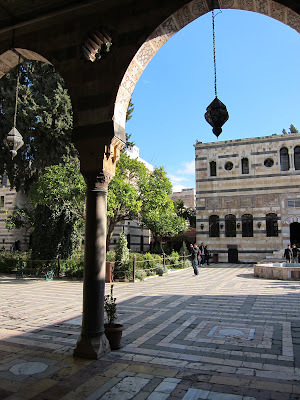We
headed toward the centre of the Syrian desert. Palmyra, known as "the
bride of the desert", is located in the Tadmor oasis. On the caravan
routes between the Mediterranean Sea and Persia, Palmyra prospered
during more than four centuries. The end of this florishing city in 274
is linked with the destiny of its heroic Queen Zenobia.
This
queen stretched Palmyra's kingdom to the South of Egypt and the
Bosphorus. Her success threatened the Roman empire and the Emperor
Aurelian raised an army to march upon Palmyra. The city was destroyed
and Queen Zenobia taken prisonner. The great kingdom never manage to get
off the ground after this defeat.


View of the old city from the citadel
Nowadays
Palmyra's old town comes down to the monumental ruins of a theatre and
the great colonnade (a one kilometre long street with columns) linking
the temple of Bel and Zenobia's palace. Parts of some other temples
are still visible. A lot of stones and colums lost in the middle of the
desert..
The great colonnade
the tetrapilon in the middle and the great colonnade on the right
The theatre
Other places of
interest: the three brothers tomb famous for its painting of Achiles and
the citadel to admire the sunset. For the bravest, we have heard that
the sunrise is fantastic but it is at 5am with a one hour walk to climb
to the citadel... ;)
Tombs valley
In front of the three brothers tomb
******
******
******
Our tour
in Syria ended with a couple of days in the great Damascus. Most of the
touristical attractions of the capital are located inside the old
town's walls. Damascus' old town has a crazy atmosphere with narrow
streets, building standing only god knows how and a lot of people
everywhere. On the main streets, every door opens to a shop, a hotel or
a restaurant.
Spices and sweets souk
Behind the crapy
facades of the old town still remain a few wonderful palaces like one
can imagine in its oriental dreams. Azem palace became the national
museum of the Arts and Popular Traditions. So its visit is a double win:
we could admire the magnificence of its decoration and architecture
and also learn about local craft, domestic lifestyle and customs.
Umayyad mosque is an imposing complexe which hosts the shrine of John
the Baptist (Prophet Yehia to Muslims). It is said to be one the most
impressive and beautiful mosque, a source of inspiration for many
architects. The prayer hall and the courtyard are richely and glittery
decorated!
A-Sayyda Ruqayya Mosque is named after a little girl, Say'yeda Roqayya,
who died of sadness after having seen the cutted head of her dead
father. Her tomb is an object of devotion. Men and women – in two
seperate areas – touch, kiss the railings surrounding the shrine and
also rub their scarves or clothes against the railings. Those scenes are
kind of impressive and moving.
******
After twenty days in Syria and Jordan, we got used to the practice of this region: wild trafic, zero respect for the pedestrians, bargaining for every price from shampoo to taxi ride, etc. Concretely, the prices of food and public transportation are far less expensive than in Europe.
Below
the train tickets we bought for a two hours trip from Aleppo to Hama.
It does not matter we do not understand what is written on the ticket..
We paid only 2,20 euros!! This second class ticket is normally 1,50
euros each. But Luis paid only one euro with its student discount and
for Axelle they justified her discount with her height?!? :) We still
have no clue where that second discount comes from... And those train
are not bad at all!
Train tickets
Last
but not least, on our crazy journey from Damascus to Iran, we had to
change flight in Sharjah.. mmh.. We spent the whole flight wondering in
which country we would land! Having no idea of the country, we could
not guess its time zone nore the duration of the flight...We also met
strange winged passagers in the boarding queue..





















No comments:
Post a Comment